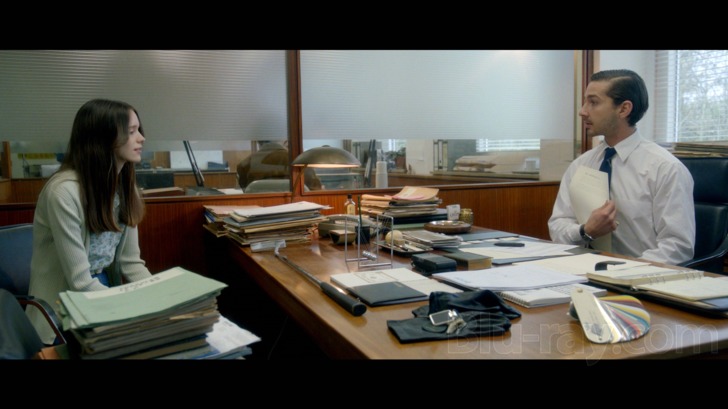Nymphomaniac: Volume I Blu-ray Movie
HomeNymphomaniac: Volume I Blu-ray Movie 
Magnolia Pictures | 2013 | 117 min | Not rated | Jul 08, 2014
Movie rating
7.3 | / 10 |
Blu-ray rating
| Users | 5.0 | |
| Reviewer | 3.0 | |
| Overall | 3.2 |
Overview
Nymphomaniac: Volume I (2013)
After he finds her bloodied and bruised in an alleyway, an older gentleman rescues Joe, a self-diagnosed nymphomaniac, and returns with her to his apartment. Over the course of the night, she recounts to him the story of her life, including her complicated relationship with her parents, how she lost her virginity, the many men she has seduced and the one man who might have been her true love.
Starring: Charlotte Gainsbourg, Stellan Skarsgård, Shia LaBeouf, Christian Slater, Connie NielsenDirector: Lars von Trier
| Drama | 100% |
| Erotic | 59% |
Specifications
Video
Video codec: MPEG-4 AVC
Video resolution: 1080p
Aspect ratio: 2.35:1
Original aspect ratio: 2.39:1
Audio
English: DTS-HD Master Audio 5.1 (48kHz, 24-bit)
Subtitles
English SDH, Spanish
Discs
50GB Blu-ray Disc
Single disc (1 BD)
BD-Live
Playback
Region A (B, C untested)
Review
Rating summary
| Movie | 2.5 | |
| Video | 4.5 | |
| Audio | 4.0 | |
| Extras | 2.0 | |
| Overall | 3.0 |
Nymphomaniac: Volume I Blu-ray Movie Review
Von Dreary
Reviewed by Michael Reuben July 7, 2014Like the first part of Quentin Tarantino's Kill Bill , Volume I of Lars von Trier's Nymphomaniac feels incomplete, which is the inevitable result when commercial considerations require that a massive epic conceived as a single experience be carved into two halves. Volume I ends abruptly—some smart aleck has no doubt already referred to it as "coitus interruptus"—while scenes from Volume II play during the credits. Still, given the episodic nature of the work, the split between the two volumes doesn't exactly break any dramatic tension. It simply provides an intermission that, if one acquires the two-disc set containing both halves, can be as long or as short as one chooses. Then again, acquiring both halves of Nymphomaniac involves something of a leap of faith, because it's entirely possible that the first volume will leave the viewer uninterested in proceeding. Despite the provocative title and explicit subject matter, Nymphomaniac is an alienating film and, in Volume I, often a dull one. It uses the enticement of explicit sex between legitimate actors (achieved through digital trickery) as a Trojan horse to introduce an array of themes about cruelty, power, emotional manipulation and depression, all perennial von Trier obsessions and all of them presented with a dreary monotony that is only fitfully enlivened by some of the film's performances. The title character's sexual exploits certainly don't energize the film. Better quality porn has been available since VHS players first appeared in the home. Artists who are driven by their obsessions are often at risk of self-parody, and von Trier is particularly so. For every Dogville, there is a Manderlay. For every The Kingdom (the Danish original, not the Stephen King remake), there is The Idiots. For every Breaking the Waves, there is a Dancer in the Dark. And now, for Melancholia, which flirted with laughable excess, we have Nymphomaniac, which replaces the former's hypnotically mysterious visuals with droning voiceover, as Charlotte Gainsbourg's Joe reflects on her life and Stellan Skarsgård's Seligman tries to participate with erudite digressions. Prodigious learning and cinematic technique are displayed in the process, but to what end?

Like many of von Trier's films, Nymphomaniac is divided into chapters with titles. They are the subheadings of the story that the title character, Joe, tells to the elderly Seligman (Skarsgård) after he finds her lying beaten and bloody in the street. She refuses to let him call the police or an ambulance but accepts the offer of a cup of tea at his home, where the bookish recluse listens to her tale and responds as best he can. In the present, Joe is played by Gainsbourg. Several child actresses play her in flashbacks, and Stacy Martin plays her as a young woman. Because Skarsgård is a reliably fine actor, he makes Seligman a credible presence, but the old man is little more than a construct, an opposite to Joe, through whom von Trier can introduce topics other than sex. Be prepared for lengthy digressions on flyfishing, literary history, the theory of polyphonic music (Seligman loves Bach) and the mathematics of the Fibonacci sequence. Somehow this is all supposed to be related to Joe's lifelong pursuit of sexual indulgence, but the connections remain obscure, other than the occasional metaphor. Indeed, there may be no real connection other than von Trier's preoccupations and his ability to force all these elements into one film. With a detached, almost indifferent tone, Joe informs Seligman that she is a terrible person, then relates her life story, beginning with a sexually precocious childhood in the company of an affectionate but frequently distant father (Christian Slater) and a cold, uncaring mother (Connie Nielsen). Joe has already become an adventurous teenager by the time her father dies of an unspecified illness, but it is Joe who experiences his death with all of its terrors and clinical indignities, because her mother can't bear hospitals. This sequence is the most emotionally charged, for Joe, of Volume I, bringing her face to face with life's transcience. This seems to commit her even more resolutely to the pursuit of sexual fulfillment that she had already begun with her friend identified only as "B" (Sophie Kennedy Clark, who played the younger version of the title character in Philomena). The man who keeps reappearing in Joe's life—under such conveniently coincidental circumstances that Seligman questions whether her story is true—is Jerôme (Shia LaBeouf). As a scruffy teen with a motorbike, he deflowers Joe (at her request). Later, when she goes on a job interview for secretarial work, Jerôme turns out to be the acting boss and hires her despite a conspicuous lack of qualifications. Later still, at a low point in Joe's life, she meets him by chance on one of her regular nature walks. By the end of Volume I, Joe has made it clear to both Seligman and the audience that she considers Jerôme to be the love of her life, but this is more of an inconvenience than a fulfillment, because she doesn't believe in love. What Joe does want is an endless succession of encounters, eight or ten a night, which she juggles according to the clock and often has trouble telling apart. As if to drive home the point, and also to de-eroticize both the subject and the film, von Trier presents a collection of male genitalia in closeup, portrait after portrait, circumcised and uncircumcised, conveying a visual equivalent of the number, focus and interchangeability of Joe's youthful encounters. Some viewers may be aroused, but most will probably be deadened, which, I suspect, is the intended effect. Far more exciting is the occasional eruption of genuine emotion in the film, of which the most conspicuous example occurs when one of Joe's lovers, Mr. H (Hugo Speer), unexpectedly leaves his wife for Joe. Mrs. H (Uma Thurman) appears at Joe's door with the couple's three little boys in tow and tears through the apartment like a vengeful fury, pouring out rage and jealousy on behalf of every wife or girlfriend for whom Joe has ever been a rival (and heedless of the terror that the scene is obviously causing the children). This is one of Volume I's best scenes, and yet you're also aware that Joe may be inventing the whole thing, just to prove to Seligman how bad she really is. (Trivia buffs have already noted that Uma Thurman starred in that other film that was split into two parts for release, Kill Bill.) Volume I ends on what was probably considered a "cliffhanger", except that it really isn't one, because the film's larger arc is clearly laid out. We know where Joe's story is heading, because we know how Seligman found her, and it's not hard to see who has the upper hand as between Joe and this solitary bachelor. The only question is how much more suffering von Trier will inflict on his characters (and the audience) before he reaches the end.
Nymphomaniac: Volume I Blu-ray Movie, Video Quality 

Chilean cinematographer Manuel Alberto Claro, who shot Melancholia for von Trier, returned for Nymphomaniac, which was photographed digitally, primarily on the Arri Alexa Plus, with some inserts shot on a Canon EOS 5D Mark II. Post-production was completed on a digital intermediate, and Magnolia Home Entertainment's 1080p, AVC-encoded Blu-ray was presumably sourced from digital files. However, the master is not identical to that used by Artificial Eye for the Region B-locked edition of Nymphomaniac: Volume I released earlier this year. A tell-tale sign is that Chapter 3, "Mrs. H", is not framed at 1.85:1, as it was on the Artificial Eye Blu-ray (and, as far as I know, on the European theatrical release; I did not see the U.S. theatrical version). Except for a few brief shots, the chapter is framed, like the rest of the film, at 2.35:1. In general, Magnolia's disc delivers a fine rendition of Nymphomaniac: Volume I , which is only to be expected in a project that has been digitally acquired and processed at every stage, with no analog conversion. The image is sharp, detailed and, except for deliberate texturing, free of noise or interference. The blacks are solid, and the colors range from the drab interiors of Seligman's abode to the brighter, contrastier scenes from Joe's earlier life, where the colors range from the cool palette of her parents' home to the warm hues of her sexual encounters. Magnolia has followed its usual practice of delivering a high average bitrate at 34.93 Mbps for Volume I, ensuring a superior image without artifacts.
Nymphomaniac: Volume I Blu-ray Movie, Audio Quality 

The sound design of Nymphomaniac: Volume I, presented on Blu-ray in lossless DTS-HD MA 5.1, is precise but straightforward. Joe's narration in the present, sometimes interrupted by one of Seligman's questions, comments or, as Joe calls them, digressions, weaves in and around the dialogue and basic sounds of the scenes she is describing. Dialogue sometimes abruptly contrasts with sounds of sexual activity, but interruption by silence can be equally effective. The film has no original score; von Trier prefers a mix of portentous classical music (e.g., an excerpt from Palestrina's "Mass Hodie Christus Natus Est") and portentous contemporary rock (e.g., Rammstein's "Führe mich", which is also used in the trailer).
Nymphomaniac: Volume I Blu-ray Movie, Special Features and Extras 

Prospective purchasers with region-free players will want to compare the extras on Magnolia's disc with those offered on the Region B-locked edition of Nymphomaniac: Volume I released earlier this year by Artificial Eye.
- The Characters (1080p; 1.78:1; 9:39): Gainsbourg, Martin, Skarsgård and LaBeouf discuss the characters they play. According to Martin, she and Gainsbourg did not try to coordinate their portrayals of Joe.
- AXS TV: A Look at Nymphomaniac (1080i: 2.35:1; 3:02): This is a superior AXS TV promo that relies more heavily on interview excerpts, including some that are not part of the interview segments on either this disc or Volume II.
- Nymphomaniac Volume I Trailer (1080p; 2.35:1; 1:47).
- Also from Magnolia Home Entertainment: The disc includes trailers for Filth, Grand Piano, The Double and The Sacrament, as well as promos for AXS TV. These also play at startup, where they can be skipped with the chapter forward button.
- BD-Live: As of this writing, attempting to access BD-Live gave the message "Check back later for updates".
Nymphomaniac: Volume I Blu-ray Movie, Overall Score and Recommendation 

When von Trier was making The Idiots, he famously stripped on set to encourage his reluctant cast to do nude scenes; the finished film contains a few stray shots where the disrobed director can be seen in the background. Sixteen years later, it's tempting to say that the auteur still has no clothes, and I don't think von Trier would argue. Everything he has done, from the quickly abandoned Dogma "vow of chastity", to the eruptions of religious faith in The Kingdom and Breaking the Waves, to the provocation of titling a film Nymphomaniac that is about so many other things, has been marked by a showman's determination to remain unique among the crowd. Sometimes the effect is brilliant, like having the doors of perception opened so that, for a moment, you really do see things differently. At other times, though, von Trier creates the maddening sensation that you've been cornered by a lunatic who demands that you join him in his insanity. I put Nymphomaniac in the latter category, but judge for yourself.
Similar titles
Similar titles you might also like
(Still not reliable for this title)

Nymphomaniac: Volume II
2013

Tell Me You Love Me
2007

9 Songs
2004

Love 3D
2015

Sex and Lucía
Lucía y el sexo | Unrated Director's Cut
2001

Antichrist
2009

Emmanuelle
1974

Shame
2011

Carmen
2003

The Brown Bunny
Limited to 250 sets / Signed & Numbered
2004

Melancholia
2011

Killing Me Softly
2002

Black Emanuelle
Emanuelle nera
1975

Belle de jour
1967

Caligula
The Imperial Edition | Caligola
1979

20th Century Women
2016

Moonlight
2016

The Silence
Tystnaden
1963

Last Tango in Paris
Ultimo tango a Parigi | Uncut Version
1972

Disobedience
2017